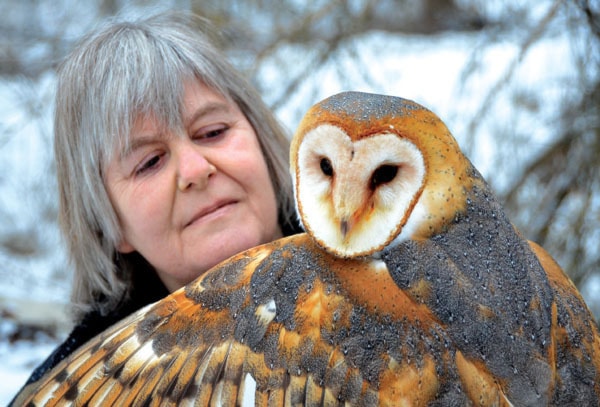After 22 years of lending a healing hand to ailing and injured wildlife, Karen Beggs has closed her Kee-Two Wildlife Rehabilitation Centre.
Despite her dedication to caring for and releasing as many of her patients as possible back into the wild for more than two decades, Beggs says she knows she will still feel guilty. And, while she has tried to get somebody to take over the operation, so far there are no takers.
“You have to have qualifications and you have to have the proper facilities. Each species has to have this, that and the other and it’s really tricky,” she says. “Most people are working. There’s no money in this.”
Beggs, a special education assistant with School District #83, says she has probably responded to some 200 to 250 calls for help each year – often on Christmas day.
Licensed federally by the Canadian Wildlife Service and provincially by the Ministry of Environment, Beggs has nursed thousands of birds ranging from eagles to hummingbirds, and many mammals, including beavers, porcupines, skunks and squirrels, among others.
Her charges have been brought to her from as far away as Golden, Nakusp, Keremeos and Princeton. Owls were often among her patients, 90 per cent of them hit by cars.
“They don’t have peripheral vision and they hunt across the highway,” Beggs says, noting that regardless of who brought injured animals to her, she was the only one to release them back into their habitat because she wanted to make sure the release was successful.
For example, in the case of one great horned owl she has since named Snina (First Nations name for owl), she discovered during release that while he could fly from a branch, when he landed on the ground he didn’t have the power to lift off again.
Missing a wing tip after being hit by a car in Vernon the 10-year-old Snina goes to school occasionally so students can have a close look at the remarkable bird.
While Snina seems happy to display his beauty, another owl let Beggs know she was not the least bit interested.
“I took her to school, but she just keeled over,” laughs Beggs. “She opened her eyes, peeked out then closed them again, but when she got home, she was fine.”
While some birds can be released anywhere successfully, Beggs always made sure birds of prey went back to their own familiar hunting territory.
“I have had a high release rate, sometimes 70 per cent, and considered to be very high,” she says. “I do things differently from a lot of people.”
Protective of her patients, Beggs has tried to keep her rehab centre as natural as possible for each of the species she helps. She does not allow visitors and although she keeps excellent records, she does not believe in over-handling.
Beggs can laugh now at some of her rescue adventures, but there was little to laugh at at the time. There was an owl that had managed to get tangled in a net covering a fish farm pond in Malakwa – right in the middle of waste-high, frigid water.
Beggs remembers another call she received to pick up an ailing raccoon in Silver Creek – in the middle of a cold night made worse by a raging blizzard.
Then there was the time someone put out a trap to catch a rabbit, but got a skunk. Having just purchased her first new vehicle, Beggs was understandably wary.
“I picked up the covered cage and gently put it into the back of the van,” she says. “I drove it to the release site, gently took the cage out, released the skunk and threw the cage back into the van.”
Only when noxious fumes filled her brand new vehicle did Beggs realize there had been two skunks in the covered cage.
Skunked more than once, Beggs laughingly describes how all the literature maintaining skunks can’t spray until they are five or six weeks old proved false when a baby nailed her right in the mouth.
“I did a lot of spitting and toothbrushing,” she laughs.
Beggs recalls one very sad experience with a coyote, who had been very badly injured by a train between Raven and town. The animal was beyond help and one of the Shuswap Veterinary Clinic doctors readily agreed to meet Beggs after hours, and not for the first time, she says, to put the coyote out of is misery.
Beggs began learning how to care for injured an ailing wildlife as a child in her father’s animal hospital on the east coast of Yorkshire.
She has worked on a ranch, for veterinarians in Victoria and Penticton, and took University of Guelph animal nutrition and biology courses.
She has three grown children and a desire to fulfill some of her other dreams, including writing a book about her experiences.
Beggs gives grateful thanks to the Shuswap and Vernon vet clinics, the Shuswap Naturalist Club, the Shuswap Community Foundation, Wildlife Control’s Pete Wise and many others who have provided assistance over 22 years.
“Anyone with a knowledge of wildlife and their needs, who can donate time to their care and who has available acreage to construct a centre, should consider this a very rewarding calling,” she says.
